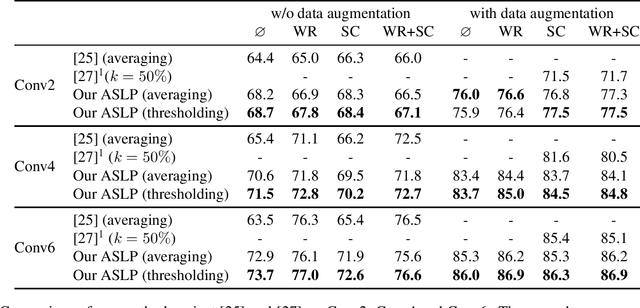Alice Lebois
Extracting Effective Subnetworks with Gumebel-Softmax
Mar 08, 2022
Abstract:Large and performant neural networks are often overparameterized and can be drastically reduced in size and complexity thanks to pruning. Pruning is a group of methods, which seeks to remove redundant or unnecessary weights or groups of weights in a network. These techniques allow the creation of lightweight networks, which are particularly critical in embedded or mobile applications. In this paper, we devise an alternative pruning method that allows extracting effective subnetworks from larger untrained ones. Our method is stochastic and extracts subnetworks by exploring different topologies which are sampled using Gumbel Softmax. The latter is also used to train probability distributions which measure the relevance of weights in the sampled topologies. The resulting subnetworks are further enhanced using a highly efficient rescaling mechanism that reduces training time and improves performance. Extensive experiments conducted on CIFAR10 show the outperformance of our subnetwork extraction method against the related work.
DVOLVER: Efficient Pareto-Optimal Neural Network Architecture Search
Feb 05, 2019



Abstract:Automatic search of neural network architectures is a standing research topic. In addition to the fact that it presents a faster alternative to hand-designed architectures, it can improve their efficiency and for instance generate Convolutional Neural Networks (CNN) adapted for mobile devices. In this paper, we present a multi-objective neural architecture search method to find a family of CNN models with the best accuracy and computational resources tradeoffs, in a search space inspired by the state-of-the-art findings in neural search. Our work, called Dvolver, evolves a population of architectures and iteratively improves an approximation of the optimal Pareto front. Applying Dvolver on the model accuracy and on the number of floating points operations as objective functions, we are able to find, in only 2.5 days, a set of competitive mobile models on ImageNet. Amongst these models one architecture has the same Top-1 accuracy on ImageNet as NASNet-A mobile with 8% less floating point operations and another one has a Top-1 accuracy of 75.28% on ImageNet exceeding by 0.28% the best MobileNetV2 model for the same computational resources.
 Add to Chrome
Add to Chrome Add to Firefox
Add to Firefox Add to Edge
Add to Edge